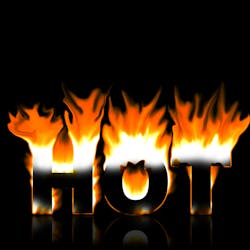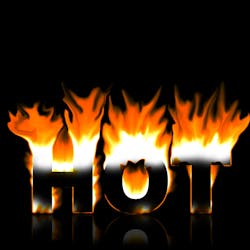The way I see it, there are three variations of hot. There is childhood hot, a world where many of us grew up sans air conditioning either at home or at school. As a kid, you were unfazed by the heat. Shorts and short-sleeve linen surfer shirts or t-shirts minimized the weather’s oppression. After-school hours or summer afternoons were spent at the community pool or under the neighbor’s lawn sprinkler. Hot was a relative concept when you were a kid.
Then there is grownup heat. The flesh-searing hot that brands the backs of your thighs the first time you rented a car with black leather seats at the Phoenix airport on a 115-degree summer day. Of course, we can’t forget wet heat, like that of New Orleans that time my team attended the ASIS convention in the city, and we all figured it would be a good idea to save 15-bucks and walk the mile through the 95-degree temps and 98% humidity from the hotel to convention facility. Nothing like standing alongside three of your male coworkers in the restroom outside the exhibit hall, stripped to the waist drying off with paper towels while your undershirts and dress shirts dried atop the hand blow-dry machine.
But the third kind of hot is a potential killer with real security implications. As E3G, an independent Global climate change think tank recently stated: “Extreme heat is becoming more frequent and severe with significant implications for human health, agricultural systems, infrastructure, and stability. The United Nations Security Council can steer the world to address this existential threat to global security. Extreme heat events are on the rise globally with climate change ‘making heat waves longer, hotter, more likely, and more dangerous.”This summer we are seeing some of the hottest global temperatures in world history, sparking devastating worldwide wildfires in Canada and Greece. Now the Western United States braces for its inevitable fire season. Axios, an independent global news organization, reports that by the end of July, it is likely that 15 days just that month will have breached an unprecedented global temperature threshold, calling it “a clarion wakeup call in the form of extreme weather.”
Whether you are a staunch climate-change advocate or denier, the facts are the facts – and they matter. They matter because opinions don’t alter the obvious truths that as Axios says, “nearly every facet of the climate system is flashing red this summer, from record-low sea ice extent in Antarctica to hot tub-like ocean waters surrounding South Florida, and all-time high-temperature records set in multiple countries on at least three continents.”
The bottom line is that this is becoming the norm. Heatwaves are increasing as the climate undergoes changes that are more severe and rapid than most scientists expected. The long-term consequences have been shared with governments and global corporations alike. But most of us are quickly realizing that the near-term consequences of our new heat reality are becoming more than an inconvenience.
The U.S. sees the heat stress manifest itself in mounting droughts and water shortages in the West and Southwestern states. As water issues mount, so does business insecurity and potential economic havoc. As eventual food and water catastrophes gain global momentum, governments are sure to experience mounting infrastructure challenges that may quickly morph into civil unrest.
Even our military is cognizant of the heat. According to U.S. military officials, when temperatures reach greater than 90 WBGT – a unit that measures heat stress in direct sunlight – physical training for U.S. military members cannot occur and the day is labeled a “black flag day.” I’m just wondering out loud if that goes for military personnel in Texas too or does the Governor’s “no water breaks” policy supersede?
U.S. Navy brass says that as we see an increase in days over 90, 100, and 105 degrees we’ll also see a decrease in the number of days physical training can be conducted. The decrease in days available for our military to train directly affects one of the core pillars of the 2017 National Security Strategy (NSS). As climate change-induced heat waves increase the number of black flag days for the U.S. military, training and readiness suffer – along with national security.
About the Author
Steve Lasky
Editorial Director, Editor-in-Chief/Security Technology Executive
Steve Lasky is Editorial Director of the Endeavor Business Media Security Group, which includes SecurityInfoWatch.com, as well as Security Business, Security Technology Executive, and Locksmith Ledger magazines. He is also the host of the SecurityDNA podcast series. Reach him at [email protected].



